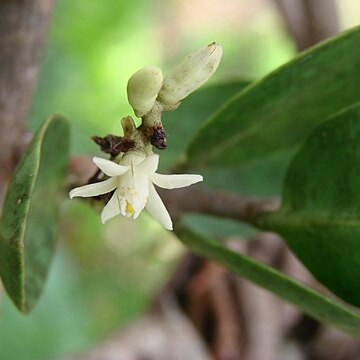Leafy parasites, glabrous or furfuraceous when young; usually epicortical roots from base of plant and, in some, also from branches. Leaves paired, petiolate. Inflorescences not subtended by bracts, basically an indeterminate raceme of sessile or pedunculate triads, each triad with at least median flower sessile, and with bracts and bracteoles which tend to be persistent; in some species, branched (compound) inflorescences in terminal and/or axillary positions. Flowers perfect or plants dioecious, 4-or mostly 6-merous, small, dark red to creamy white; when unisexual, aborted organs of opposite sex present; stamens dimorphic in most species, with basifixed anthers, filaments short and stout, longer ones often with lateral depressions accommodating anthers of shorter ones; style rather massive, with shape of anthers impressed upon it, and thus of uneven thickness. Fruit a berry of diverse colors; seed with copious white endosperm; embryo at maturity bright green, fleshy, dicotylous, with well differentiated haustorial disk. (x = 8, 16).
Erect or scandent shrubs, the latter developing aerial roots. Leaves mostly leathery. Flowers often very tiny, tetra-hexamerous, in ternations; these in racemes, spikes, panicles or rarely subsolitary; bractlets connate. Stamens unequal, the filaments of the longer scalloped at both sides by pressure of the anthers of the shorter ones. Pollen grains of one type; triangular in shape, the exine finely granulose, showing three pores. Pistillate flowers with staminodia; staminate ones with vestigial style, this lacking stigma; androgynous flowers sometimes occur. Buds of the male flowers terete. Fruit baccate as in Struthanthus.

